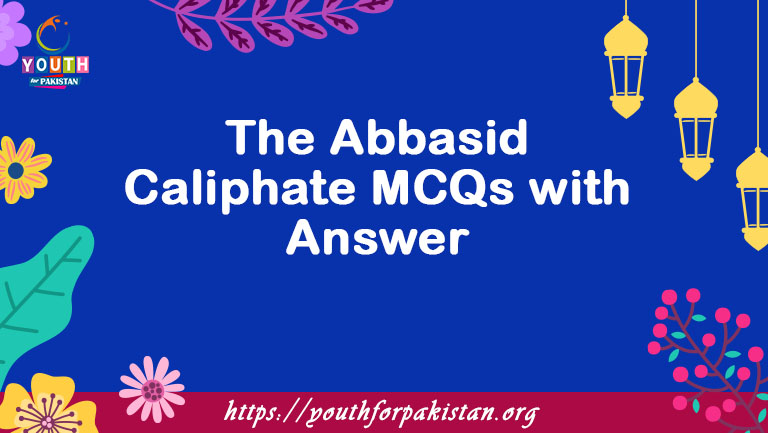The following are The Abbasid Caliphate MCQs with answers related to Islamic Studies. We have arranged the most important and repeated MCQs in all the competitive examinations. The students can clear their concepts for The Abbasid Caliphate MCQs online quiz by attempting these.
The Abbasid Caliphate Online MCQs with Answers
Who was the founder of the Abbasid Caliphate?
a) Umar ibn al-Khattab
b) Ali ibn Abi Talib
c) Abu Bakr al-Siddiq
d) Abu al-Abbas al-Saffah
During which century did the Abbasid Caliphate reach its zenith in terms of cultural and scientific achievements?
a) 6th century
b) 8th century
c) 10th century
d) 12th century
Which city served as the capital of the Abbasid Caliphate?
a) Mecca
b) Medina
c) Baghdad
d) Damascus
Who is known as the “Golden Caliph” of the Abbasid Caliphate due to his patronage of art and culture?
a) Harun al-Rashid
b) Al-Mamun
c) Al-Mutasim
d) Al-Mu’tadid
Which famous work of literature is set during the reign of Caliph Harun al-Rashid and features tales of Scheherazade?
a) The Iliad
b) The Odyssey
c) One Thousand and One Nights (Arabian Nights)
d) The Divine Comedy
What was the name of the round city built by Caliph al-Mansur as the original core of Baghdad?
a) Al-Andalus
b) Alhambra
c) Al-Mansuriya
d) Al-Khwarizmi
Who is credited with translating many Greek and Roman texts into Arabic during the Abbasid Caliphate, helping preserve classical knowledge?
a) Al-Farabi
b) Ibn Rushd (Averroes)
c) Al-Razi (Rhazes)
d) Hunayn ibn Ishaq
Which Caliph of the Abbasid Caliphate established the House of Wisdom, a major center for translating and preserving ancient texts?
a) Al-Mamun
b) Al-Mansur
c) Al-Mu’tasim
d) Al-Mu’tadid
Who was the most famous scholar associated with the House of Wisdom and known for his contributions to mathematics, including the term “algebra”?
a) Al-Farabi
b) Ibn Rushd (Averroes)
c) Al-Khwarizmi
d) Ibn Sina (Avicenna)
What important work by the Persian scholar Ibn al-Haytham, known as Alhazen in Latin, influenced the field of optics and vision?
a) “The Book of Healing”
b) “The Canon of Medicine”
c) “The Book of Optics”
d) “The Muqaddimah”
During the Abbasid Caliphate, which religious group experienced significant expansion and cultural achievements in fields such as philosophy and science?
a) Sunni Muslims
b) Shiite Muslims
c) Sufi mystics
d) Jewish scholars
What is the name of the famous Islamic scholar and physician who authored the medical encyclopedia “Kitab al-Hawi?
a) Al-Farabi
b) Ibn Rushd (Averroes)
c) Al-Razi (Rhazes)
d) Ibn Sina (Avicenna)
Which famous Abbasid Caliph promoted the translation of Greek and Roman texts, leading to the translation movement in the House of Wisdom?
a) Harun al-Rashid
b) Al-Mamun
c) Al-Mutasim
d) Al-Mu’tadid
What branch of mathematics was significantly advanced by Islamic scholars during the Abbasid Caliphate, leading to developments in algebra and trigonometry?
a) Geometry
b) Algebra
c) Calculus
d) Statistics
Who was the famous Persian polymath known for his contributions to various fields, including astronomy, mathematics, and poetry, during the Abbasid era?
a) Al-Farabi
b) Ibn Rushd (Averroes)
c) Al-Razi (Rhazes)
d) Omar Khayyam
What is the term for the extensive network of trade routes that facilitated the exchange of goods and ideas during the Abbasid Caliphate?
a) Silk Road
b) Spice Route
c) Trans-Saharan Trade
d) Mediterranean Trade
Who is known for his famous work “The Book of Healing,” a philosophical and scientific encyclopedia during the Abbasid Caliphate?
a) Al-Farabi
b) Ibn Rushd (Averroes)
c) Al-Razi (Rhazes)
d) Ibn Sina (Avicenna)
What is the term for the art of intricate paper-folding, often associated with Islamic culture and mathematics?
a) Origami
b) Calligraphy
c) Mosaic
d) Tessellation
Who is known for his work on the concept of free will and determinism in Islamic philosophy during the Abbasid era?
a) Al-Farabi
b) Ibn Rushd (Averroes)
c) Al-Razi (Rhazes)
d) Ibn Sina (Avicenna)
What is the term for the art of intricate geometric patterns and designs used in Islamic art and architecture?
a) Arabesque
b) Cubism
c) Surrealism
d) Islamic
Who is known for his work on the concept of free will and determinism in Islamic philosophy during the Abbasid era?
a) Al-Farabi
b) Ibn Rushd (Averroes)
c) Al-Razi (Rhazes)
d) Ibn Sina (Avicenna)
Which field of study was significantly influenced by Islamic scholars during the Abbasid Caliphate, leading to advancements in navigation and exploration?
a) Cartography
b) Paleontology
c) Botany
d) Sociology
What is the term for the extensive collection of hadith (sayings and actions of the Prophet Muhammad) compiled during the Abbasid Caliphate?
a) Tafsir
b) Ijma
c) Sunnah
d) Hadith
Which Islamic philosopher and theologian played a significant role in reconciling Greek philosophy with Islamic thought during the Abbasid Caliphate?
a) Al-Farabi
b) Ibn Rushd (Averroes)
c) Al-Razi (Rhazes)
d) Ibn Sina (Avicenna)
What is the term for the decorative, tiled mosaic often found in Islamic architecture, especially in mosques?
a) Fresco
b) Stained glass
c) Iznik
d) Mosaic
Who is known for his pioneering work in the field of optics, including the study of lenses and the principles of refraction?
a) Al-Farabi
b) Ibn Rushd (Averroes)
c) Al-Razi (Rhazes)
d) Ibn al-Haytham (Alhazen)
What is the term for the decorative script used in Islamic calligraphy, often used for Quranic verses and religious texts?
a) Cursive
b) Nastaliq
c) Kufic
d) Roman
Which Islamic scholar and physician is known for his contributions to the field of ophthalmology and the treatment of eye diseases?
a) Al-Farabi
b) Ibn Rushd (Averroes)
c) Al-Razi (Rhazes)
d) Ibn al-Haytham (Alhazen)
What is the term for the Islamic practice of charitable giving and almsgiving, which played a significant role in supporting scholarship and the needy during the Abbasid Caliphate?
a) Zakat
b) Ijma
c) Hajj
d) Sawm
Who is known for his work “The Book of Healing,” a philosophical and scientific encyclopedia during the Abbasid Caliphate?
a) Al-Farabi
b) Ibn Rushd (Averroes)
c) Al-Razi (Rhazes)
d) Ibn Sina (Avicenna)
What is the term for the art of storytelling and oral tradition, which thrived during the Abbasid Caliphate and contributed to the preservation of cultural narratives?
a) Calligraphy
b) Tafsir
c) Oral history
d) Sunnah
Who was the famous Abbasid Caliph credited with promoting the translation of Greek, Roman, and Indian texts into Arabic, thus preserving and transmitting knowledge?
a) Harun al-Rashid
b) Al-Mamun
c) Al-Mutasim
d) Al-Mu’tadid
What is the term for the system of legal principles and judgments based on Islamic law, which played a central role in Islamic governance during the Abbasid Caliphate?
a) Sharia
b) Fiqh
c) Ijtihad
d) Fatwa
Which Abbasid Caliph is known for his significant contributions to the field of music, including inventing musical instruments?
a) Harun al-Rashid
b) Al-Mamun
c) Al-Mutasim
d) Al-Mu’tadid
What was the term for non-Arab converts to Islam who often faced discrimination and were sometimes referred to as “clients”?
a) Mawali
b) Ulama
c) Sufis
d) Emirs
Which famous traveler from Morocco journeyed extensively through the Abbasid Caliphate and beyond, documenting his experiences in the travelogue “Rihla”?
a) Ibn Battuta
b) Marco Polo
c) Zheng He
d) Christopher Columbus
What architectural feature is commonly found in Abbasid mosques and serves as a niche indicating the direction of Mecca for prayer?
a) Minbar
b) Minaret
c) Mihrab
d) Mihra
Which Abbasid Caliph is known for his efforts to suppress the use of images, leading to the destruction of artwork and the practice of iconoclasm?
a) Harun al-Rashid
b) Al-Mamun
c) Al-Mutasim
d) Al-Mu’tadid
What is the term for the religious pilgrimage to Mecca, one of the Five Pillars of Islam, which played a significant role in the cultural exchange during the Abbasid Caliphate?
a) Hajj
b) Umrah
c) Zakat
d) Sawm
Who was the first Abbasid Caliph to take the title “Caliph of the East and the West” and establish diplomatic relations with Charlemagne?
a) Harun al-Rashid
b) Al-Mamun
c) Al-Mutasim
d) Al-Mu’tadid
What famous battle in 750 CE marked the end of the Umayyad Caliphate and the rise of the Abbasid Caliphate?
a) Battle of Siffin
b) Battle of Tours
c) Battle of Karbala
d) Battle of the Zab
Who is known for his famous work “The Book of Healing,” a philosophical and scientific encyclopedia during the Abbasid Caliphate?
a) Al-Farabi
b) Ibn Rushd (Averroes)
c) Al-Razi (Rhazes)
d) Ibn Sina (Avicenna)
What is the term for the Islamic practice of charitable giving and almsgiving, which played a significant role in supporting scholarship and the needy during the Abbasid Caliphate?
a) Zakat
b) Ijma
c) Hajj
d) Sawm
Who was the famous Abbasid Caliph credited with promoting the translation of Greek, Roman, and Indian texts into Arabic, thus preserving and transmitting knowledge?
a) Harun al-Rashid
b) Al-Mamun
c) Al-Mutasim
d) Al-Mu’tadid
What is the term for the system of legal principles and judgments based on Islamic law, which played a central role in Islamic governance during the Abbasid Caliphate?
a) Sharia
b) Fiqh
c) Ijtihad
d) Fatwa
Which Abbasid Caliph is known for his significant contributions to the field of music, including inventing musical instruments?
a) Harun al-Rashid
b) Al-Mamun
c) Al-Mutasim
d) Al-Mu’tadid
What was the term for non-Arab converts to Islam who often faced discrimination and were sometimes referred to as “clients”?
a) Mawali
b) Ulama
c) Sufis
d) Emirs
Which Abbasid Caliph is known for his efforts to suppress the use of images, leading to the destruction of artwork and the practice of iconoclasm?
a) Harun al-Rashid
b) Al-Mamun
c) Al-Mutasim
d) Al-Mu’tadid
What is the term for the religious pilgrimage to Mecca, one of the Five Pillars of Islam, which played a significant role in the cultural exchange during the Abbasid Caliphate?
a) Hajj
b) Umrah
c) Zakat
d) Sawm
Who was the first Abbasid Caliph to take the title “Caliph of the East and the West” and establish diplomatic relations with Charlemagne?
a) Harun al-Rashid
b) Al-Mamun
c) Al-Mutasim
d) Al-Mu’tadid










